

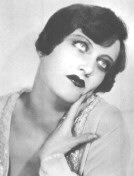
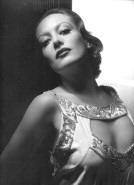




The Best of M
 MacDougall,
Ranald (3/10/15 - 12/12/73). Co-wrote the screenplay for 1947's Possessed;
wrote the Oscar-nominated screenplay for Mildred Pierce (1945) and for
Queen Bee (1955). He also made his directorial debut with Queen Bee.
MacDougall,
Ranald (3/10/15 - 12/12/73). Co-wrote the screenplay for 1947's Possessed;
wrote the Oscar-nominated screenplay for Mildred Pierce (1945) and for
Queen Bee (1955). He also made his directorial debut with Queen Bee.
 Machado,
Walter (1917 - 2012). Brazilian author/scholar who wrote the
747-page 1993 Joan biography Joan Crawford: Uma Homenagem.
Currently available in Portuguese only.
Machado,
Walter (1917 - 2012). Brazilian author/scholar who wrote the
747-page 1993 Joan biography Joan Crawford: Uma Homenagem.
Currently available in Portuguese only.
See this site's Books: Machado page devoted to the author and his book about Joan.
And here's a Portuguese blog post with info about Machado's career.
 Mack,
Willard (9/18/1873 - 11/18/1934).
Mack,
Willard (9/18/1873 - 11/18/1934).
Wrote
the story for Joan's 1925 silent film Old
Clothes,
and wrote the dialogue for 1929's Untamed.
Tabloid side-note: He was
once married to two of Joan's co-stars: Marjorie Rambeau (1912-1917)
and Pauline Frederick (1917-1920).
Born
"Charles Willard McLaughlin" in Canada, Mack was raised
in Brooklyn and Iowa, and attended D.C.'s Georgetown University
before becoming an actor and writer. He debuted on Broadway in 1914
in a play he had written ("So Much for So Much"). From
1914 to 1928, he wrote 22 plays, appearing in 10 of them. He began
a screenwriting career in 1917; from then until his death in 1934,
he wrote or co-wrote dozens of film scripts, also acting in
and directing some of them.
AFI Catalog page. Wikipedia page. Internet Broadway page. Bizarre Los Angeles quotes.
MacLaine, Shirley. In CWJC, Joan says that MacLaine is "immensely gifted, and someday, when she really sorts things out, I think she'll be one of our truly great actresses, though I have a hunch she'll move toward the stage. But she's such a splendid dancer it would be a shame if she confines herself to just one career." Joan adds elsewhere in the book: "...hell, Shirley MacLaine has balls, too, but that lady knows how to use them. I didn't..."
 Maddin,
Guy. (2/28/56 - ) Canadian director.
In a 5/10/04 interview with the UK's Weekly Telegraph to promote his film The
Saddest Music in the World, he waxes philosophic about Joan and especially
her role in Possessed
('47):
Maddin,
Guy. (2/28/56 - ) Canadian director.
In a 5/10/04 interview with the UK's Weekly Telegraph to promote his film The
Saddest Music in the World, he waxes philosophic about Joan and especially
her role in Possessed
('47):
Guy Maddin has just jetted in on the red-eye from Winnipeg, Manitoba,
but
he's full of beans and bursting with opinions about his chosen movie. "I'm in
a delirium," he says breezily. "But it's a good delirium for interviews. I'm
like Joan on sodium pentothal."
"Joan" is the dishevelled Joan Crawford
who, at the beginning of Possessed, is found wandering the streets in a state
of near-catatonia. Psychiatrists give her a shot of the "truth
drug," ushering in a flashback to the love affair that induced her
condition.
"My way into making movies has always been through grand
emotions," Maddin says. "And Possessed is one of the great treatments
of unrequited love and jealousy and obsession and madness, done with
all the studio polish of a 1940s Hollywood movie. I first saw it about
15 years ago and it was a door swinging open to a rich
wonder-world."
His own, ultra low-budget films are both homages to and
affectionate parodies of this long-lost era. Absurdist, poetic and humorous,
their lush images, overwrought emotions and extreme situations make
Lars von Trier look like a model of sobriety. "Movies shouldn't be
under any obligation to be earthbound and real," Maddin says. "They
should have the freedom of music or painting."
Over a prolific career
spanning nearly two decades, he has built up a quiet cult following. Now,
with a retrospective and the release of his new movie, The Saddest Music in
the World - a typically bizarre fable starring Isabella Rossellini as a beer
baroness with glass legs - he may find a wider audience.
"Melodrama is
not life exaggerated; it's life uninhibited," he continues. "In our dreams,
we get to scream and cry and hit people - all the things we're not allowed to
do during waking hours. And in melodramas, everyone follows these dream-like
levels of behaviour. I teach a film class at the University of Manitoba and I
make my students describe their greatest humiliation. They hand their
essays to me, the fools, and I post them on the internet (only
joking). Then, when they say that Possessed is ludicrous, high-pitched
and exaggerated, I remind them of what they just wrote down."
Not to
be confused with the 1931 film of the same title, also starring Crawford,
Possessed was shot shortly after the star's move from MGM to Warner Brothers.
Previously branded box-office poison, the actress went on to make a suite of
dark, brooding hits - Mildred Pierce, Humoresque, Possessed and Sudden Fear -
that netted her an Oscar and two further nominations.
"Her career
spanned five decades and as many reinventions. She was a flapper in the 1920s
in silent movies and a glamourpuss in the 1930s. After the great Warner
Brothers years, she starts to become this eerie symbol of decay, leading up
to What Ever Happened to Baby Jane? Unfortunately, she died before she could
follow Bette Davis into actual senescence."
Was Crawford's charisma
tarnished by her daughter's notorious memoir, Mommie Dearest? "Perhaps it was
enhanced," says Maddin mischievously. "She was also the CEO of Pepsi for a
while, so she's every bit as titanic in her own way as Michael Jackson, an
odd, unlikely mix of business acumen and a mythic public image.
"She's one of the greatest screen sufferers. And one of the great Medea types, the great avengers. Her all-consuming fury is a frightening force in a film. In fact, Possessed feels like an ancient Greek tragedy. Hollywood was kind of in love with psychiatry in the 1940s and the shrinks get used here as a Greek chorus."...
Maddin also introduced a showing of The Unknown at the 2008 San Francisco Silent Film Festival.
Madonna. While we Joan fans remain peeved with Madonna for not mentioning Joan in her 1990 hit single "Vogue," Madonna is, nonetheless, partially redeemed by her 1998 video for "The Power of Good-Bye," from the Ray of Light album, which pays homage to Joan's famous beach scene from 1946's Humoresque.
Thanks to Madonna fan Simon Robinson for this Wikipedia entry for the song, which mentions Humoresque.
 Mamacita.
Real name "Anna P. Brinke
(nee Hoffman)." Born
7/26/1898 to August Hoffmann and Pauline Pelc. Died 5/2/1979 at
Sheppard Air Force Base, Wichita Falls, Texas, of liver cancer.
She is buried at Crestview Memorial Park Cemetery in Wichita Falls.
Findagrave.com.
Mamacita.
Real name "Anna P. Brinke
(nee Hoffman)." Born
7/26/1898 to August Hoffmann and Pauline Pelc. Died 5/2/1979 at
Sheppard Air Force Base, Wichita Falls, Texas, of liver cancer.
She is buried at Crestview Memorial Park Cemetery in Wichita Falls.
Findagrave.com.
See also, via Google maps, her final residence with her daughter, at 4622 Sierra Madre Drive in Wichita Falls. [Editor's Note: Brinke died only 48 miles from Lawton, Oklahoma, where Joan spent part of her childhood, from 1910 to 1916. And, in a very minor (but interesting-to-me) coincidence: My family lived in Iowa Park, 10 miles from Brinke's home in Wichita Falls, for the majority of the 1970s, and my Air Force father was stationed at Sheppard during that time.]
Anna Brinke was Joan's maid and personal assistant, whom Joan first hired in 1960 or '61 and who worked for Joan until 1974.
A mother of 9, Brinke hailed from the town of Werdhol, Germany, and later moved to Riverhead, Long Island, to live with family, which is where Joan "discovered" her.
After renting a house in Westhampton and having no one to help her there, Joan called a neighbor for a recommendation; the neighbor's maid recommended her own mother, whom Joan readily approved of after hearing that the woman liked to scrub floors on her hands and knees rather than using a mop. "Mamacita" got her nickname since Joan had just returned from a trip to Rio de Janeiro and had been hearing "-cita" applied to everything. (My Way of Life)
Thereafter, "Mamacita" became Joan's live-in helper in New York City, as well as a constant traveling companion.
In his 1980 book, There's No Place Like Home, decorator Carleton Varney describes Mamacita's function in Joan's 1960s household (in this particular case, her 1960s Fifth Avenue penthouse):
Mamacita was her field marshal. She was in charge of giving orders to the floor cleaner, rug cleaner, window cleaner, and all the regular household help. Not only did she see to it that everything in the star's life was clean but also that it matched. Mamacita was fastidious about laying out Joan's wardrobe, whether Joan was at home in New York or traveling. If Joan planned to wear a pink dress, Mamacita laid out shoes, hat, gloves, and jewelry to match, all taken from closets catalogued and labeled in an organized manner that rivaled the Dewey Decimal System.... Over the years I knew Joan, Mamacita left the actress's employ only twice, both times to visit her family in Germany. Joan did not always talk nicely to Mama, but Mama was ever indulgent, never failing to call her "Miss Crawford" in the most respectful terms, and going about her daily chores with a great deal of energy. She never slept in a maid's room, for Joan gave as much attention to the decoration of Mama's room as she did to her own. After all, Mamacita was her companion. When the secretaries and cleaners had departed and the phones had stopped ringing, it was Mama who sat with Joan late at night in the sterile white kitchen, and it was Mama on whom she depended. Her name was no accident. I regret that Mamacita left Joan's employ before her death.
"Mamacita" apparently left Joan's employ in 1974. Click here to read a March 1974 letter from Joan to Mrs. Brinke's daughter Erna: "I do hope we hear from Mama soon. I am very sorry we have had so many problems." Joan adds a handwritten note at the end: "Erna dear, Enclosed is Mama's check. I hope she received the others. I haven't called as I haven't heard from her -- I did write but she hasn't answered..."
The 1977 bio Raging Star quotes Joan's manservant of 15 years, "Grant," re Mamacita's "disappearance":
She [Brinke] left madame [Joan] to visit her family in Germany. Her brothers and sisters always wanted her to spend a holiday with them, but when it was time to return to New York, there was trouble with her visa, and she was gone longer than expected. In the meantime madame had to find someone else to replace her. Mamasita [sic] finally came back to America and these days lives in Texas with her own daughter who is happily married a second time. Both her daughter and son-in-law love her and have given her a home where she is very happy.
Public interest in Brinke was revived in 2017, when the character of "Mamacita" was portrayed in the FX series "Feud" by veteran NY actress Jackie Hoffman, who received nominations for an Emmy award and a Critics' Choice television award for her performance.
EDITOR'S NOTES:
(1) I was informed by a reader that the suffix "-cita" is Spanish, not Portuguese, as is spoken in Brazil's Rio de Janeiro. JC herself relayed the story in MWOL (p. 150 of the hardcover), but I thought I'd pass along the possible discrepancy.
(2) Thanks to Brinke's grandson Mark Flatman for some of the biographical information and the below photos, up for sale on eBay.
Below left: Anna Brinke, early 1950s in Germany, with husband Alois, son, and two grandkids. Below right: 1966 reading a German newspaper on a plane.


Man from U.N.C.L.E., The. See Karate Killers.
 Mannequin.
MGM, 1938. Directed by Frank Borzage, 95 minutes. (Originally
titled Three Rooms in Heaven, according to a 1937 LA Times promo piece.)
Joan stars as "Jessica
Cassidy," a working girl who marries a conniving low-life (Alan Curtis)
and is then wooed by a wealthy businessman (Spencer Tracy,
in their only film together). Says Joan in CWCJ:
Mannequin.
MGM, 1938. Directed by Frank Borzage, 95 minutes. (Originally
titled Three Rooms in Heaven, according to a 1937 LA Times promo piece.)
Joan stars as "Jessica
Cassidy," a working girl who marries a conniving low-life (Alan Curtis)
and is then wooed by a wealthy businessman (Spencer Tracy,
in their only film together). Says Joan in CWCJ:
...a mistake all the way around; Spencer Tracy was so miscast he made an absolute muddle out of my part, which wasn't all that great to begin with. At first I felt honored working with Spence, and we even whooped it up a little bit off the set, but he turned out to be a real bastard. When he drank he was mean, and he drank all through production. He'd do cute things like step on my toes when we were doing a love scene--after he chewed on some garlic. Metro tried to co-star us again, but I begged them to let me off, and they did. I'm sorry I can't say nicer things about him; maybe he improved later, but from the things I've heard about his relationship with Kate, I doubt it. But worse, the script for Mannequin was all wrong.
 March,
Fredric (8/31/1897 - 4/14/1975). Lauded American actor who appeared in films
from 1921 to 1973, as well as on the stage. Twice, he won both the
Best Actor Oscar (1931 Dr. Jekyll and Mr. Hyde, 1946 The
Best Years of Our Lives) and the Best Actor Tony (1947 Years
Ago, 1956 Long Day's Journey Into Night)--- a feat also
accomplished only by Helen Hayes.
March,
Fredric (8/31/1897 - 4/14/1975). Lauded American actor who appeared in films
from 1921 to 1973, as well as on the stage. Twice, he won both the
Best Actor Oscar (1931 Dr. Jekyll and Mr. Hyde, 1946 The
Best Years of Our Lives) and the Best Actor Tony (1947 Years
Ago, 1956 Long Day's Journey Into Night)--- a feat also
accomplished only by Helen Hayes.
March co-starred with Joan in 1940's Susan and God. Said Joan in Conversations with Joan Crawford: It was a very difficult part, and I owe a lot to Fredric March--he played foil to me very generously.
Political Addendum: During his life, and posthumously, March was a victim of two witch hunts: (1) In 1938, he was one of many Hollywood personalities investigated by the House Un-American Activities Committee (HUAC). (2) In 2018, his alma mater, the University of Wisconsin-Madison, re-named the Fredric March Play Circle Theater because March once belonged to a student group called the "Ku Klux Klan"---which had no ties at all to the national racist KKK organization, although that fact did not stop the 2018 fascists and weakling school administrators. From the 2018 report:
These students established their Ku Klux Klan as an unmasked, above-ground inter-fraternity society composed of leading students. Its members included (from the 1921-1922 class): senior and sophomore class presidents, members of the student senate, student court, the Badger yearbook board, the alumni committee, the prom and homecoming committees, the university traditions committee, the Campus Religious Council, and nearly all varsity sports squads and theatrical companies. Members of this Klan group also occupied leadership roles on the Student Union board, the YMCA cabinet, the Memorial Union fund drive committee, the athletic board, and the Daily Cardinal. There is no evidence that this group was ever affiliated with the Knights of the Ku Klux Klan, nor do we know what these 1919 founders knew or thought about the organization that Simmons founded in 1915. [Editor's Note: Why, then, the change of name of the Fredric March Play Circle Theater?]
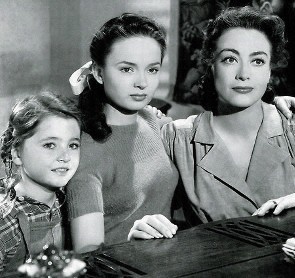 Marlowe,
Jo Ann. (12/15/35 1/02/91)
Marlowe,
Jo Ann. (12/15/35 1/02/91)
Born "Jo Ann Mares" in Nebraska, Marlowe was spotted during a family trip to Los Angeles by a Hollywood director, which led to her first (uncredited) role in 1942's Yankee Doodle Dandy. Her film career lasted from 1942 to 1950; her most famous role was in 1945's Mildred Pierce, as the lovable, tomboyish younger sister "Kay Pierce," who dies about halfway through the film.
After leaving acting, Marlowe went on to receive a law degree from Loyola Marymount University in 1960, then worked as a trial lawyer for the US Attorney's Office in Los Angeles (winning 95% of her cases, according to her aunt).
In 1968, Marlowe suffered a cerebral hemorrhage in a car accident; she was subsequently in a coma for over 22 years, and died at age 55 at her mother's home.
Wikipedia page. IMDb page. Fremont, Nebraska, death notice. Find-a-Grave page.
Maugham, W. Somerset. Author of the 1921 book Rain and Other Stories. (Originally published under the title The Trembling of a Leaf.) Both the play Rain and Joan's 1932 film Rain were based on his story of the same name.
 Mayer,
Louis B. (7/4/1885 - 10/29/57) Paternalistic head of MGM from 1924 to
1951. Son of a scrap dealer, he made his own fortune by running a
chain of nickelodeons in the New England area (opening his first in 1907) and
investing in The Birth of a Nation. He came west to Hollywood in 1918
to produce pictures; there, Marcus Loew asked him to run the newly merged "Metro"
and "Goldwyn" production companies, which then became "Metro-Goldwyn-Mayer."
He was forced from power in 1951 in favor of Dore Schary. (See also MGM.)
Mayer,
Louis B. (7/4/1885 - 10/29/57) Paternalistic head of MGM from 1924 to
1951. Son of a scrap dealer, he made his own fortune by running a
chain of nickelodeons in the New England area (opening his first in 1907) and
investing in The Birth of a Nation. He came west to Hollywood in 1918
to produce pictures; there, Marcus Loew asked him to run the newly merged "Metro"
and "Goldwyn" production companies, which then became "Metro-Goldwyn-Mayer."
He was forced from power in 1951 in favor of Dore Schary. (See also MGM.)
Joan says in CWJC: ...at Metro we were lucky because Louis B. didn't believe in the casting couch routine...Mayer decided that his stars should be totally immune to the temptations of sex, alcohol, gambling, fast driving, drugs, flying, profanity, etc...He may have been a tyrant at times, but he taught me discipline, and he made me feel that I could be a star, and he made me act like a star.
Once Joan appeared at a studio lunch for MGM exhibitors wearing slacks with a scarf around her hair: He took one look at me, turned absolutely red, and told me to go back home and dress the way a star should be seen in public, and to never appear looking the way just "any woman" would...I never again appeared in public, at least consciously, looking like "just any woman." To this day some little--or big--voice inside me says, "Joan, go out there looking like a star." And I'm damned uncomfortable when I don't...Mayer opposed my first three marriages but acted as marriage counselor. He opposed all three divorces, but he acted as my divorce counselor. Make what you can of that. (CWJC) More Mayer info.
McCallum, David. British actor, co-star with Joan in the 1967 The Man From U.N.C.L.E movie called The Karate Killers.
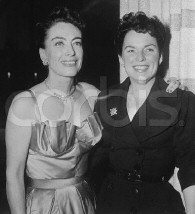 McCambridge,
Mercedes. (3/17/18 - 3/2/04) Feisty character actress whose "Emma
Small" played foil to Joan's "Vienna" in 1954's Johnny Guitar.
The two feuded off-set, too, with a drunken Joan at one point throwing
all of McCambridge's clothes onto the highway. In her 1981 autobiography, McCambridge
called Joan a "mean, tipsy, powerful, rotten-egg lady." McCambridge
received a Supporting Actress Oscar for her debut role in All the King's
Men (1949) and was also nominated for Giant ('56). Other notable
films include Orson Welles' A Touch of Evil ('58) and The Exorcist
('73), where she played the voice of the devil. IMDb
info.
McCambridge,
Mercedes. (3/17/18 - 3/2/04) Feisty character actress whose "Emma
Small" played foil to Joan's "Vienna" in 1954's Johnny Guitar.
The two feuded off-set, too, with a drunken Joan at one point throwing
all of McCambridge's clothes onto the highway. In her 1981 autobiography, McCambridge
called Joan a "mean, tipsy, powerful, rotten-egg lady." McCambridge
received a Supporting Actress Oscar for her debut role in All the King's
Men (1949) and was also nominated for Giant ('56). Other notable
films include Orson Welles' A Touch of Evil ('58) and The Exorcist
('73), where she played the voice of the devil. IMDb
info.
 McCoy,
Tim (4/10/1891 - 1/29/1978).
McCoy,
Tim (4/10/1891 - 1/29/1978).
MGM Western star who was top-billed in two of Joans silent films: Winners of the Wilderness (1927) and Law of the Range (1928).
A veteran of both World Wars, Colonel Tim McCoy was born in Michigan and left college in Chicago after seeing a travelling Wild West show. He settled in Wyoming, where he worked as a ranch hand and in rodeos. He also developed an interest in Native American culture, which led to a Hollywood job providing Indian extras for silent Westerns before being hired in 1925 to star in his own Western---the beginning of a 40-year film career. McCoy was also an early TV pioneer with his own live show (1952) in Los Angeles. McCoy's honors include a star on the Hollywood Walk of Fame, as well as induction into the Hall of Great Western Performers of the National Cowboy and Western Heritage Museum.
AFI Catalog page. IMDB page. Wikipedia page.
McKenzie, Elsa. Dancer at MGM during Joan's earliest films. Said she of Joan:
She absolutely astonished us. Hollywood was rather genteel in those days--ladies didn't say "damn" or "hell." And here came this gal from New York who smoked and said "son-of-a-bitch" and told dirty jokes to the crew--we were flabbergasted. But she worked hard, probably harder than anyone else on the set, and once in a while, when she relaxed, you could see something in her eyes that was like--well, like fright and loneliness mixed together. (CWJC)
 Medlinsky,
Harvey. Director, Christina Crawford's first
husband. The couple met while Christina was appearing in a Chicago stage production
of Barefoot in the Park; Medlinsky was the stage director. (LW says that
play co-star, screen legend Myrna
Loy, "was at first unaware of the romance
between the two and couldn't figure out why Medlinsky was letting Christina
get away with behavior that would normally have gotten a cast member fired.") They married
on 5/20/66
in New York City, with Joan in attendance. Christina flew to Mexico in October
of '68 for a divorce.
Medlinsky,
Harvey. Director, Christina Crawford's first
husband. The couple met while Christina was appearing in a Chicago stage production
of Barefoot in the Park; Medlinsky was the stage director. (LW says that
play co-star, screen legend Myrna
Loy, "was at first unaware of the romance
between the two and couldn't figure out why Medlinsky was letting Christina
get away with behavior that would normally have gotten a cast member fired.") They married
on 5/20/66
in New York City, with Joan in attendance. Christina flew to Mexico in October
of '68 for a divorce.

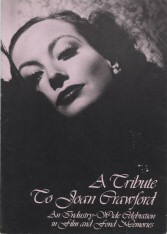 Memorial Services.
Joan's NYC memorial service was held at All Soul's Unitarian Church (Lexington
Ave. at 80th St.) on Tuesday, May 17, 1977, at 2 p.m. 1500 people attended.
The order of the procedures:
The Reverend Dr. Walter Donald Kring read the 23rd Psalm. Geraldine Brooks and
Anita Loos delivered eulogies. Pearl Bailey sang "He'll Understand."
Cliff Robertson gave another eulogy. Then Dr. Kring read "Desiderata"
and gave the benediction. (JCB says that Joan's Christian Science practitioner,
Mrs. Markham, also spoke, though the program doesn't mention her.)
Memorial Services.
Joan's NYC memorial service was held at All Soul's Unitarian Church (Lexington
Ave. at 80th St.) on Tuesday, May 17, 1977, at 2 p.m. 1500 people attended.
The order of the procedures:
The Reverend Dr. Walter Donald Kring read the 23rd Psalm. Geraldine Brooks and
Anita Loos delivered eulogies. Pearl Bailey sang "He'll Understand."
Cliff Robertson gave another eulogy. Then Dr. Kring read "Desiderata"
and gave the benediction. (JCB says that Joan's Christian Science practitioner,
Mrs. Markham, also spoke, though the program doesn't mention her.)
Click here to see the invitation and program for the NYC memorial service.
The Beverly Hills memorial service for Joan was held June 24, 1977, at the Academy of Motion Picture Arts and Sciences in the Samuel Goldwyn Theater. Director George Cukor read a tribute and scenes from her movies were shown. Click here to read the full text of Cukor's comments, which were originally published in the New York Times on 5/22/77.
Merrick, Jim. Metro publicist on many Joan pictures. (In CWJC, Joan mentions him dragging her to a press conference, saying "Just relax. If they like you in person they'll love you in print, and that's what it's all about.")
Metro-Goldwyn-Mayer (MGM). The premier studio in the Golden Age of Hollywood, and Joan's studio from 1925 until 1943. In the '30s, Joan, Norma Shearer, and Garbo were the major actresses there. Said Joan:
...that was the best place to be. Mayer wanted a sort of family feeling, and in a way he got it. There was a definite morality, which could be a pain in the ass sometimes, but it was a lot better than being under contract to another studio...At MGM we had a certain dignity; we didn't feel like whores...most of those years at Metro were happy ones. In fact, until I was labeled box-office poison [1938] it was like drifting on a high tide...I was grateful to Metro for taking me out of the chorus line (my God, that was damned hard work!...) and doubly grateful for making me a star, with all the money and preferential treatment... When I decided that I actually could become an actress they tried their damndest to make me one, helped me with coaching, and had the guts to give me good, demanding parts in films like Grand Hotel and Strange Cargo that made me forget about the dogs that came in between...
Some disadvantages, however:
We were so totally owned by the studio we could have had "Property of MGM" tattoed on our backsides...We were studio property. We were groomed and coaxed and ordered to present ourselves just so on and off the screen...we really forfeited our own private ability to make decisions. (CWJC)
See also The Middle Years and Mildred Pierce entries for ways that Metro abandoned her at a certain time in her career.

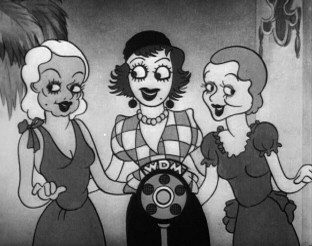
Mickey's Gala Premier. Disney short (7 min.) that premiered July 1, 1933. Distributed by United Artists, directed by Burt Gillett. The premise: Mickey and friends arrive at Grauman's for the premiere of their film Galloping Romance. Dozens of cartoon real-life celebrities are also present, alighting from limos and sitting in the audience. Cartoon Joan (in Rain get-up), accompanied by Jean Harlow and Janet Gaynor, sings a ditty and is later also spotted briefly in the audience.
Middle Years, The. In CWJC, Joan says that these years--1938, 1939, 1940--"were the years of the big, the really big, changes" in the movie industry, when the industry "seemed absolutely determined to create new highs and new lows. The trauma--God!" By the time The Women was released in '39, Joan says:
[B]y then I'd reached, in quotes, 'a certain age,' and a whole new generation of people going to the movies didn't remember me or relate to me or just didn't give a shit. At Metro we had Judy Garland and Mickey Rooney and Lana Turner and Elizabeth Taylor and Ava Gardner, and even that shrieking little thing, Jane Powell...coming on strong, winning the big audiences, consequently getting the pictures with big budgets and big promotions. It was a whole new ball game. Thalberg was dead and the concept of the quality 'big' picture pretty much went out the window, and then we had that cornball Dore Schary, and all his little message pictures that didn't work, and his fights with Mayer, and the war, with all those stupid musicals and propaganda pictures, none of which were for me. Well, I was good at surviving, and that's all I did until Mildred Pierce...
I'd like to say that I didn't resent the changes, but I did. I hated growing older. (Christ, I'd already matured, now I was just growing older.) And I didn't like second billings and I didn't like the fact that the public preferred to watch Lana Turner or Betty Grable or Judy Garland instead of me...It's funny, you know that nothing lasts forever, but when your world comes tumbling down you can feel really crushed. And I felt crushed, as though those goddam middle years were a sort of endless menopause...
...I didn't fare as badly as some of the others. (We females were, you know, relegated to obscurity when the studio or the audience, whichever, decided that the big parts had to be written for men.) Poor Norma [Shearer] just faded away to Switzerland after Irving wasn't around to protect her stardom. Metro had the atrocious taste to star Garbo--mind you, after she was so great in Ninotchka--in a piece of trash called Two-Faced Woman, a film which offended absolutely everyone, and drove her out of Hollywood. Luise Rainer, despite two Oscars, couldn't get a part in a dog show. Hedy Lamarr was shoplifting and Vivien Leigh was having nervous breakdowns and Liz Taylor was getting married all the time and Judy Garland was strung out on dope and Lana Turner was part of the Mafia--and nobody, but nobody, gave a damn about what happened to any of us because the studio was making money on the newcomers and that situation prevailed until their own total incompetence and television broke the bank. It was a strange period, however you judge it. They might just as well have sent all the women "of a certain age" to Alaska and pensioned us off...
There was this person inside me, knowing she wanted to do good things, great things, and knew she could do them, but on the outside there was this woman with a plastic face nobody really wanted to see. About that time, there was a very popular song, "Have I Stayed Too Long at the Fair," and it crushed me every time I heard it, because I was afraid I had.
The Midshipman. 1925 film starring Ramon Novarro. Joan appeared as an extra. See the Midshipman film page.
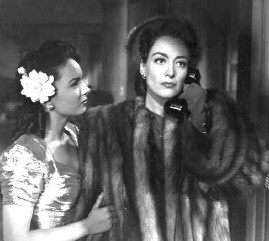 Mildred
Pierce. Warner Brothers, 1945. Directed by Michael Curtiz, 111 minutes.
Joan's starring debut at Warners after leaving longtime studio MGM, in a role
as a long-suffering mother/businesswoman that won her the Oscar for Best Actress. The
film was based on the 1941 James M. Cain novel, and also received Oscar noms
for Best Picture, Best Supporting Actress (Eve Arden and Ann Blyth),
Best Cinematography, and Best Screenplay. In 1996 the US National Film Preservation
Board added it to the National Film Registry.
Mildred
Pierce. Warner Brothers, 1945. Directed by Michael Curtiz, 111 minutes.
Joan's starring debut at Warners after leaving longtime studio MGM, in a role
as a long-suffering mother/businesswoman that won her the Oscar for Best Actress. The
film was based on the 1941 James M. Cain novel, and also received Oscar noms
for Best Picture, Best Supporting Actress (Eve Arden and Ann Blyth),
Best Cinematography, and Best Screenplay. In 1996 the US National Film Preservation
Board added it to the National Film Registry.
Says Joan in CWJC:
First of all credit--big credit--where credit is due. To Jim Cain, who wrote the novel and created a character so real she couldn't help play... To Ranald MacDougall--where is he now?--who did the screenplay. To Jack Carson, Ann Blyth, Zachary Scott, George Tobias and Eve Arden, who breathed life into the subsidiary characters. To Jerry Wald, who had a sharp, clear vision of what the picture should be, as the producer, but who let some vital changes be made as we shot. And to Michael Curtiz, one of the four truly great directors I've worked with, who had the great good sense to let Mildred grow beyond the original script.
I remember how I felt the night the Awards were presented. Hopeful, scared, apprehensive, so afraid I wouldn't remember what I wanted to say, terrified at the thought of looking at those people, almost hoping I wouldn't get it, but wanting it so badly--no wonder I didn't go. I stayed home and fortified myself, probably a little too much, because when the announcement came, and then the press, and sort of a party, I didn't make much sense at all, even though I wanted to spill over...
I've got to admit I was thumbing my nose at Metro for not supporting me in that department through all the years when they threw their big blocs of votes to Shearer or Garbo...What about Susan and God, A Woman's Face, and Strange Cargo? I'd given better performances in those pictures than I did in Mildred Pierce. All without recognition...I think the Academy voters honored me as much that night for A Woman's Face and Strange Cargo and maybe Grand Hotel as they did for Mildred. Or maybe it was for just staying around that long. Hollywood is like that; they compensate for their sins of omission later on, like the special awards they had to vote to Chaplin and Garbo in order not to seem completely ridiculous...
And funny, the morning after, when I realized the award wasn't a dream after all, I realized that Mildred Pierce really rang down the curtain on "my" Hollywood. The character I played in that film was a composite of the roles I'd always played--and a few elements from my own personality and character. (Not the long-suffering bit; I'm too much of a Christian Scientist to suffer very long at a stretch.) My professional and personal worlds had changed so much---good friends were dying or moving away---the public was restless about making up its mind what it wanted to see---the studios were in bigger and bigger trouble. No, my day, my long and golden and often glorious day, had ended, and Mildred Pierce was sort of the bittersweet celebration of the end...
...In some respects everything that happened afterward--except [last husband] Alfred--was anti-climactic...It's like being a mountain climber: After you've done Everest, what's next? And, why?
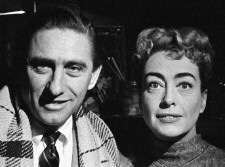 Miller,
David. (11/28/09 - 4/14/92) Joan's director of Sudden Fear ('52)
and The Story of Esther Costello ('57), and her date to the March
'53 Academy Awards show. (He also directed the remake of The Women--The
Opposite Sex--in '56 and Doris Day's
Midnight Lace in '60.)
Miller,
David. (11/28/09 - 4/14/92) Joan's director of Sudden Fear ('52)
and The Story of Esther Costello ('57), and her date to the March
'53 Academy Awards show. (He also directed the remake of The Women--The
Opposite Sex--in '56 and Doris Day's
Midnight Lace in '60.)
Click here for a 1982 interview on TheColumnist.com with an overview of his career, including specific mentions of his two Joan films.
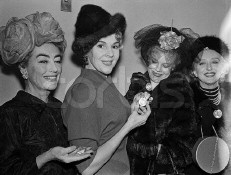 Millinery
Institute of America. On January 10, 1960, Joan was one of the institute's
seven recipients
of a "Golden Hat Award" for being one of the "best-hatted women
in America."
Millinery
Institute of America. On January 10, 1960, Joan was one of the institute's
seven recipients
of a "Golden Hat Award" for being one of the "best-hatted women
in America."
Miscarriages of Joan. Says Joan in CWJC after interviewer Newquist asked if she'd had a botched abortion at age 14 that prevented her from having children:
I wanted children desperately, and while I was married to Franchot I had seven miscarriages, some of them damned painful. None of the doctors I went to could understand why I couldn't carry full-term. One of them...finally decided that I'd picked up something from raw milk when I was a kid, and that's why I aborted. Now, honestly, would a woman who was that badly damaged by an abortion even try to have children? ...Let any woman who's miscarried in the fourth month, which I did three times, tell you it isn't trying. Baby, it's bad news.
Miss America Pageant. Joan was a judge for the pageant on 9/9/61 and 9/11/65, each held in Atlantic City and broadcast on CBS.
Mocambo. Nightclub on Sunset Strip. Joan gave daughter Christina a surprise 15th birthday party here. (MD)
 Mommie
Dearest. Joan's estranged daughter Christina published this portrait (originally,
and appropriately, titled The Hype) of a Bon Ami-and-wire hanger-wielding
Joan in 1978 (William Morrow and Co.). Click here
to read Carl Johnes' account of how the book was initially shopped around (see
Part One of the article). And here for a 1960 profile
of Christina in "Redbook" magazine that is a prototype for the later
book.
Mommie
Dearest. Joan's estranged daughter Christina published this portrait (originally,
and appropriately, titled The Hype) of a Bon Ami-and-wire hanger-wielding
Joan in 1978 (William Morrow and Co.). Click here
to read Carl Johnes' account of how the book was initially shopped around (see
Part One of the article). And here for a 1960 profile
of Christina in "Redbook" magazine that is a prototype for the later
book.
The over-the-top Paramount movie came out in 1981; directed by Frank Perry, 129 minutes, starring Faye Dunaway as Joan and Diana Scarwid as the older Christina. (In 1990, the film received the Razzie award for Worst Picture of the Decade; in 1982, it was nominated for a then-record 9 Razzies, taking home 5 of them: Worst Picture/Actress/Screenplay/Supporting Actor/Supporting Actress.)
While the disgruntled and disinherited Christina and Christopher appear to be Joan's only children in the movie, in reality she had two younger adopted daughters, Cathy and Cynthia, who say that their mother bore little resemblance to the book/movie's portrayal. Click here to read a 1981 People magazine interview with all four kids. (See also the Motherhood entry.)
 Monroe,
Marilyn. (6/1/26 - 8/5/62) Screen goddess and pop-culture icon. Monroe
signed with Twentieth Century-Fox in 1946 and debuted on film in 1947 in
a bit part, but first garnered real attention in two other small roles in
1950: In John Huston's The Asphalt Jungle, and in All About Eve. By
1953 she was voted Best New Actress by Photoplay magazine after appearing
in Niagara. In 1959 she received a Golden Globe for Best Actress in a
Comedy for Some Like It Hot and in '62 gained another Golden Globe for
Female World Film Favorite. She starred in 30 films before her early death,
the last 1961's The Misfits, co-starring Clark Gable (his last film
also) and written by her soon-to-be ex-husband Arthur Miller.
Monroe,
Marilyn. (6/1/26 - 8/5/62) Screen goddess and pop-culture icon. Monroe
signed with Twentieth Century-Fox in 1946 and debuted on film in 1947 in
a bit part, but first garnered real attention in two other small roles in
1950: In John Huston's The Asphalt Jungle, and in All About Eve. By
1953 she was voted Best New Actress by Photoplay magazine after appearing
in Niagara. In 1959 she received a Golden Globe for Best Actress in a
Comedy for Some Like It Hot and in '62 gained another Golden Globe for
Female World Film Favorite. She starred in 30 films before her early death,
the last 1961's The Misfits, co-starring Clark Gable (his last film
also) and written by her soon-to-be ex-husband Arthur Miller.
Monroe incurred the wrath of Joan during the above-mentioned Photoplay awards dinner when she showed up in a provocatively tight, low-cut gold dress that drew sustained whistles from the assembled guests. An uncharacteristically prim Joan told friend/reporter Bob Thomas, "It was the most shocking display of bad taste I have ever seen. Look, there's nothing wrong with my tits, but I don't go around throwing them in people's faces." In an AP article published the next day, Thomas quoted Joan further:
Certainly her picture isn't doing business, and I'll tell you why. Sex plays a tremendously important part in every person's life. People are interested in it, intrigued with it. But they don't like to see it flaunted in their faces. Kids don't like her. Sex plays a growingly important part in their lives, too; and they don't like to see it exploited. And don't forget the women. They're the ones who pick out the movie entertainment for the family. They won't pick anything that won't be suitable for their husbands and children. The publicity has gone too far, and apparently Miss Monroe is making the mistake of believing her publicity... She should be told that the public likes provocative feminine personalities; but it also likes to know that underneath it all the actresses are ladies....
Funnily, Monroe told Louella Parsons in response: "I cried all night. I've always admired Miss Crawford for being such a wonderful mother--for taking four children and giving them a fine home. Who better than I knows what that means to homeless little ones?" (CM)
According to various Joan bios, the backstory for Joan's outrage had to do with a drunken pass that Joan had made at Monroe that was rebuffed. Alleged years for this occurrence vary, as does the time and location---a 1953 Sunday brunch at Joan's (LW), dinner at Joan's (DF), a 1948 cocktail party at Joan's (CM)...All stories involve Joan offering wardrobe advice and dresses for Monroe to try on; in some versions Marilyn disrobes, in some she doesn't... The truth seems to be that the two women actually did have sex, but that Monroe wasn't interested in continuing the relationship. In a 2003 Monroe bio by Matthew Smith, who had access to transcripts of tapes Monroe made for her psychiatrist, Marilyn says: Oh yes, Crawford. We went to her house from a cocktail party, feeling no pain. We went to the bedroom and went down on each other. Crawford had a gigantic orgasm and shrieked like a maniac. Next time I saw her she wanted another round. I told her straight out I didn't enjoy it much, doing it with a woman. After I turned her down she became spiteful. (Click here for a sanitized excerpt of their meeting from Monroe's My Story.)
On the evening of Monroe's death, a drunken Joan went to director George Cukor's house. Cukor asked why she was so upset, since she'd never liked Monroe; Joan answered: You're right. She was cheap, an exhibitionist. She was never a professional, and that irritated the hell out of people. But, for God's sake, she needed help. She had all these people on her payroll. Where the hell were they when she needed them? Why in hell did she have to die alone? (DF)
 Montana
Moon. MGM, 1930. Directed by Malcolm St. Clair, 71 minutes. Joan stars as
"Joan Prescott," a rich rancher's daughter who falls in love
with a cowboy (Johnny
Mack Brown). This semi-talkie/semi-musical is
considered to be the very first "singing cowboy" picture. Says Joan in CWJC: ...a bit of fluff that was supposed to help Johnny Mack Brown, but
I think it hurt him instead. It was awful.
Montana
Moon. MGM, 1930. Directed by Malcolm St. Clair, 71 minutes. Joan stars as
"Joan Prescott," a rich rancher's daughter who falls in love
with a cowboy (Johnny
Mack Brown). This semi-talkie/semi-musical is
considered to be the very first "singing cowboy" picture. Says Joan in CWJC: ...a bit of fluff that was supposed to help Johnny Mack Brown, but
I think it hurt him instead. It was awful.
 Montgomery,
Robert. (5/21/04 - 9/27/81) Joan's co-star in 6 films (her 4th most frequent co-star after
Gwen
Lee, Gable, and Tone): Untamed ('29), Our Blushing Brides ('30),
Letty Lynton ('32), Forsaking All Others ('34), No More Ladies
('35), The Last of Mrs. Cheyney ('37). See his Earl
of Hollywood
site, which includes photo galleries and descriptions of his films with Joan.
Montgomery,
Robert. (5/21/04 - 9/27/81) Joan's co-star in 6 films (her 4th most frequent co-star after
Gwen
Lee, Gable, and Tone): Untamed ('29), Our Blushing Brides ('30),
Letty Lynton ('32), Forsaking All Others ('34), No More Ladies
('35), The Last of Mrs. Cheyney ('37). See his Earl
of Hollywood
site, which includes photo galleries and descriptions of his films with Joan.
 Montmartre
Cafe. Hollywood club opened in 1923 by Eddie Brandstatter at
6757 Hollywood Blvd. (at Highland). Joan
got her name in the papers by hanging out here for "girlfriend
lunches" and "tea dances" with other starlet friends.
Montmartre
Cafe. Hollywood club opened in 1923 by Eddie Brandstatter at
6757 Hollywood Blvd. (at Highland). Joan
got her name in the papers by hanging out here for "girlfriend
lunches" and "tea dances" with other starlet friends.
Geography photos.
Moore,
Dickie. Child star who played Joan's acquired son in The
Bride Wore Red.
Click here
to read excerpts about Joan from Moore's bio Twinkle, Twinkle,
Little Star.
 Moreno,
Rita. In an April 2008 interview with "Gay City News,"
this Oscar-Tony-Grammy-Emmy-award-winning actress/singer/dancer
talked about her encounter with Joan on Oscar
night 1962, after Moreno had won the Best Supporting Actress
Oscar for "West Side Story":
Moreno,
Rita. In an April 2008 interview with "Gay City News,"
this Oscar-Tony-Grammy-Emmy-award-winning actress/singer/dancer
talked about her encounter with Joan on Oscar
night 1962, after Moreno had won the Best Supporting Actress
Oscar for "West Side Story":
The funniest part was that Joan Crawford was co-hosting that
night and she had her Pepsi-cola cooler in her dressing room, filled
with vodka, and the lady was bombed. I went into the wings and only
then did I burst into tears. And she grabbed me, and there was one lone
photographer in the wings, not in the press room, and she put her arms
around me and pressed my face to her chest while he was taking
pictures. She was built like a linebacker and I couldn't get out of her
grasp. She kept saying, 'There, there dear, don't feel bad!' And I kept
saying, 'I don't feel bad! I don't feel bad!' And the photographer kept
saying, "Oh, Miss Crawford we need to see Rita's face!' 'But the poor
dear is upset,' she said, and in my muffled voice I kept saying, 'I'm
not upset!'
Finally the man came to get me, and they had to
wrest me out of her hold and take me to the press room. The best part
is a week later, in Manila, I get this note in her famous blue
stationary: 'Darling Rita' - I never met the woman in my life - 'how
generous and kind of you to come visit me in my dressing room'- we
weren't in her dressing room, we were in the wings - 'at the most
important moment in your life. How dear and sweet of you. Love, Joan.'
Morgan, Ira H. (4/2/1889 - 4/10/1959) A cinematographer for many of Joan's films, including Pretty Ladies ('25), Twelve Miles Out ('27), The Taxi Dancer ('27), Spring Fever ('27), West Point ('27), and The Duke Steps Out ('29).
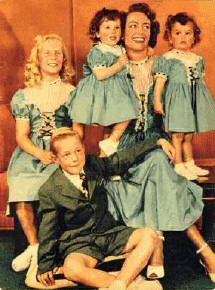 Motherhood.
Says Joan in CWJC:
Motherhood.
Says Joan in CWJC:
I'm aware that there were times when I didn't pay enough attention to [my children], and times when I was too strict. I expected them to appreciate their advantages, the things they had as children that I hadn't had, but in Hollywood that's hard to do. If we, as adults, couldn't find reality, how could they? Anyway, despite certain problems we've had I loved them, and do, and I think they loved me, and do. But you'll have to ask them....
I think I would also have spent more time with my children. Real time, sharing and understanding, not just there when it came to discipline and problems. Perhaps they wouldn't have needed more time with me--they go off into lives of their own when they're very young--but it would have been better time....
I do think if I'd been harder on myself, professionally, and on everyone associated with my professional life, I would have been an easier person, a happier person, in my personal life. I'd have been easier on people around me, especially my husbands and the kids. It's as though I was having such a god-awful time learning my part in life that I never really had the time to project myself into other people's positions, to find out what they were feeling. I'm afraid that through most of my life, if you took a sympatico rating on the scale of one to ten, I'd have come out zero.
See also the Mommie Dearest entry.
 Murray,
Feg (5/15/1894 - 7/16/73)
Murray,
Feg (5/15/1894 - 7/16/73)
Frederic "Feg" Murray was an Olympic medallist (1920 bronze in 110-m hurdles) and cartoonist, whose syndicated "Seein' Stars" celebrity comic strip ran daily from 1933 to 1941, and then on Sundays from '41 to '51.
Click here to see 11 strips featuring Joan that appeared from 1936 to 1948.
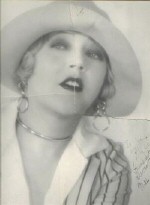 Murray,
Mae. (5/10/1889 - 3/23/65)
Murray,
Mae. (5/10/1889 - 3/23/65)
This early MGM star, known as "The Girl with the Bee-Stung Lips," was an inspiration for Joan upon the latter's arrival in Hollywood in 1925. Says Joan in POJ: "[I watched] Mae Murray, whom I came to admire for the measure of her tremendous discipline over her body. She was a dancer, and every facet of her dancing technique came to bear on her performance."
Murray began her career as a Ziegfeld Follies girl, and appeared in films from 1916 to 1931, including two with Valentino; her biggest hit was 1925's The Merry Widow, co-starring John Gilbert and directed by Erich von Stroheim, whom she referred to as a "dirty hun." (She was also married from 1918 to 1925 to Joan-director Robert Z. Leonard.)
IMDb info. Silents Are Golden article.
 Murray,
Nickolas. (1892 - 1965) Hungarian photographer who took a series of beach shots
of Joan and first husband Doug Fairbanks, Jr., for the October 1929 issue of Vanity Fair magazine.
Murray,
Nickolas. (1892 - 1965) Hungarian photographer who took a series of beach shots
of Joan and first husband Doug Fairbanks, Jr., for the October 1929 issue of Vanity Fair magazine.
Muscular Dystrophy Association.
Muskoka Lake. Canadian lake where Joan vacationed with ex-husband Franchot Tone for a week in 1966. (His family had owned a lodge there since his childhood.) After his death in 1968, Joan complied with his last wishes and had his ashes scattered there. (JCB)
 My
Way of Life. Joan's 1971 "Script for a Complete Woman" shares
her hints for beauty, decorating, entertaining, etc. 224 pages, published by
Simon and Schuster.
My
Way of Life. Joan's 1971 "Script for a Complete Woman" shares
her hints for beauty, decorating, entertaining, etc. 224 pages, published by
Simon and Schuster.
See this site's Books page for more info.
